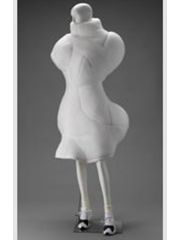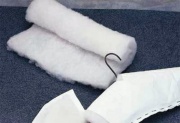Difference between revisions of "Batting"
| (36 intermediate revisions by 2 users not shown) | |||
| Line 1: | Line 1: | ||
| − | [[File: | + | [[File:MFA20174430 Batting.jpg|thumb|Polyester batting dress<br>MFA# 2017.4430]] |
| + | [[File:Quilt-batting-loft.jpg|thumb|Quilt Batting<br>Generation Quilt Patterns]] | ||
== Description == | == Description == | ||
| + | A soft cushion of loosely matted fibers. Batting is used for padding and insulation in upholstered furniture, cushions, packing, and quilts. It is usually made from [[cotton]], or [[polyester%20fiber|Polyester]], and occasionally [[wool]]. For museum applications, 100% heat-bonded polyester batting is recommended. Some battings that are resin bonded may include materials that off-gas or attract pests. Additionally some battings are sold with scrim, or gauze, a lightweight and translucent textile usually made from cotton or [[polypropylene]] on one or both surfaces to provide positioning stability when needed, such as for quilting. | ||
| − | + | {| class="wikitable" | |
| − | + | |- | |
| + | ! Fiber | ||
| + | ! Composition | ||
| + | ! Loft | ||
| + | ! Shrinkage | ||
| + | ! Applications | ||
| + | |- | ||
| + | | Natural Cotton | ||
| + | | 100% Natural Cotton | ||
| + | | 1/16" | ||
| + | | 3–5% | ||
| + | | Soft, natural, chemical free, and easy-to-needle; breathable; | ||
| + | |- | ||
| + | | White Cotton | ||
| + | | 100% Bleached Cotton | ||
| + | | 1/16" | ||
| + | | 3–5% | ||
| + | | Natural, lightweight, and soft; breathable; used when color matters ; | ||
| + | |- | ||
| + | | 80/20 Natural Blend | ||
| + | | 80% Cotton 20% Polyester | ||
| + | | 1/16" | ||
| + | | 2–3% | ||
| + | | Provides strength, stability, and support without adding stiffness or bulk; remains lightweight and soft | ||
| + | |- | ||
| + | | 60/40 Natural Blend | ||
| + | | 60% Cotton 40% Polyester | ||
| + | | 1/8” | ||
| + | | 2–3% | ||
| + | | Provides extra support and durability; specially designed for all types of machine quilting | ||
| + | |- | ||
| + | | Polyester | ||
| + | | 100% Polyester | ||
| + | | 1/4" | ||
| + | | 0-2% | ||
| + | | Soft and lofty; less expensive than wool; not breathable (can become hot when used in a quilt); can be slippery | ||
| + | |- | ||
| + | | Bamboo blend | ||
| + | | 50% [[Bamboo]] 50% Cotton | ||
| + | | 1/16" | ||
| + | | 2–3% | ||
| + | | Breathable and cool by nature with natural anti-bacterial properties; softer than cotton | ||
| + | |- | ||
| + | | Wool | ||
| + | | 10% Wool | ||
| + | | 3/8" | ||
| + | | 0-3% | ||
| + | | Airy, resilient loft; reathable (in quilts this means cool in summer and warm in winter) | ||
| + | |- | ||
| + | | Soy Blend | ||
| + | | 50% [[Soybean fiber|Soy fiber]] 50% Cotton | ||
| + | | 1/16" | ||
| + | | 2–3% | ||
| + | | Very thin and soft, allows needle to pass with ease | ||
| + | |} | ||
== Synonyms and Related Terms == | == Synonyms and Related Terms == | ||
| + | batt; stuffing; wadding; padding, Pellon | ||
| + | [[File:979-1000.jpg|thumb|Polyester Batting<br>Credit: University Products]] | ||
| − | + | == Applications == | |
| + | * Cushioning and fill in cavities around stored or packed artifacts | ||
| + | * Incorporated in padded textile hangars or stockinette tubes | ||
| − | == | + | == Collection Risks == |
| + | Batting fibers can easily snag on small object parts. Additionally, polyester fibers may be abrasive. This may be mitigated by separating batting from the object with a fabric or non-woven layer. | ||
| − | + | == Physical and Chemical Properties == | |
| + | Polyester is non-absorbent, pest resistant, and provides cushioning 'memory' | ||
| − | + | == Working Properties == | |
| + | Cotton fibers are hygroscopic and may provide some humidity buffering, but the cotton batting tends to flatten with time and may also attract insects. [http://www.paccin.org/content.php?65-Batting (PACCIN)] | ||
| − | + | == Forms/Sizes == | |
| − | + | Roll lengths vary and widths typically 40” or 45” up to 90”. Thickness (referred to as "loft") ranges from .007” to 1”. Can easily be stacked to achieve more substantial thicknesses. Some versions provide easily separable layers. | |
| − | * Art and Architecture Thesaurus Online, | + | == Resources and Citations == |
| + | * Pellon Projects: [https://www.pellonprojects.com/wp-content/uploads/2013/03/Batting-FAQs.pdf Batting FAQs]; [https://www.pellonprojects.com/wp-content/uploads/2015/11/PellonBattingChartNEW.pdf Batting Comparison] | ||
| + | * Rachael Perkins Arenstein, Lisa Goldberg, and Eugenie Milroy, ‘Support and Rehousing for Collection Storage’ In ‘Preventive Conservation: Collection Storage’ Lisa Elkin and Christopher A. Norris (eds.), Society for the Preservation of Natural History Collections, New York. 2019. | ||
| + | * [https://www.nps.gov/museum/publications/conserveogram/18-02.pdf?pdf=18-2 Safe Plastics and Fabrics for Exhibit and Storage], Conserve O Gram 18/2, National Park Service, September 2010. | ||
| + | * Preparation, Art Handling, Collections Care Information Network [http://www.paccin.org/content.php?62-Materials (PACCIN)] | ||
| + | * Marjorie Shelley, ''The Care and Handling of Art Objects'', The Metropolitan Museum, New York, 1987 | ||
| + | * Hoechst Celanese Corporation, ''Dictionary of Fiber & Textile Technology'' (older version called Man-made Fiber and Textile Dictionary, 1965), Hoechst Celanese Corporation, Charlotte NC, 1990 | ||
| + | * ''Fairchild's Dictionary of Textiles'', Phyllis G.Tortora, Robert S. Merkel (eds.), Fairchild Publications, New York City, 7th edition, 1996 | ||
| + | * ''The American Heritage Dictionary'' or ''Encarta'', via Microsoft Bookshelf 98, Microsoft Corp., 1.998 | ||
| + | * Art and Architecture Thesaurus Online, https://www.getty.edu/research/tools/vocabulary/aat/, J. Paul Getty Trust, Los Angeles, 2000 | ||
| − | [[Category:Materials database]] | + | [[Category:Materials database]] [[Category:PACCIN]][[Category:MWG]][[Category: Cushioning]] |
Latest revision as of 11:24, 8 November 2023
Description
A soft cushion of loosely matted fibers. Batting is used for padding and insulation in upholstered furniture, cushions, packing, and quilts. It is usually made from Cotton, or Polyester, and occasionally Wool. For museum applications, 100% heat-bonded polyester batting is recommended. Some battings that are resin bonded may include materials that off-gas or attract pests. Additionally some battings are sold with scrim, or gauze, a lightweight and translucent textile usually made from cotton or Polypropylene on one or both surfaces to provide positioning stability when needed, such as for quilting.
| Fiber | Composition | Loft | Shrinkage | Applications |
|---|---|---|---|---|
| Natural Cotton | 100% Natural Cotton | 1/16" | 3–5% | Soft, natural, chemical free, and easy-to-needle; breathable; |
| White Cotton | 100% Bleached Cotton | 1/16" | 3–5% | Natural, lightweight, and soft; breathable; used when color matters ; |
| 80/20 Natural Blend | 80% Cotton 20% Polyester | 1/16" | 2–3% | Provides strength, stability, and support without adding stiffness or bulk; remains lightweight and soft |
| 60/40 Natural Blend | 60% Cotton 40% Polyester | 1/8” | 2–3% | Provides extra support and durability; specially designed for all types of machine quilting |
| Polyester | 100% Polyester | 1/4" | 0-2% | Soft and lofty; less expensive than wool; not breathable (can become hot when used in a quilt); can be slippery |
| Bamboo blend | 50% Bamboo 50% Cotton | 1/16" | 2–3% | Breathable and cool by nature with natural anti-bacterial properties; softer than cotton |
| Wool | 10% Wool | 3/8" | 0-3% | Airy, resilient loft; reathable (in quilts this means cool in summer and warm in winter) |
| Soy Blend | 50% Soy fiber 50% Cotton | 1/16" | 2–3% | Very thin and soft, allows needle to pass with ease |
Synonyms and Related Terms
batt; stuffing; wadding; padding, Pellon
Applications
- Cushioning and fill in cavities around stored or packed artifacts
- Incorporated in padded textile hangars or stockinette tubes
Collection Risks
Batting fibers can easily snag on small object parts. Additionally, polyester fibers may be abrasive. This may be mitigated by separating batting from the object with a fabric or non-woven layer.
Physical and Chemical Properties
Polyester is non-absorbent, pest resistant, and provides cushioning 'memory'
Working Properties
Cotton fibers are hygroscopic and may provide some humidity buffering, but the cotton batting tends to flatten with time and may also attract insects. (PACCIN)
Forms/Sizes
Roll lengths vary and widths typically 40” or 45” up to 90”. Thickness (referred to as "loft") ranges from .007” to 1”. Can easily be stacked to achieve more substantial thicknesses. Some versions provide easily separable layers.
Resources and Citations
- Pellon Projects: Batting FAQs; Batting Comparison
- Rachael Perkins Arenstein, Lisa Goldberg, and Eugenie Milroy, ‘Support and Rehousing for Collection Storage’ In ‘Preventive Conservation: Collection Storage’ Lisa Elkin and Christopher A. Norris (eds.), Society for the Preservation of Natural History Collections, New York. 2019.
- Safe Plastics and Fabrics for Exhibit and Storage, Conserve O Gram 18/2, National Park Service, September 2010.
- Preparation, Art Handling, Collections Care Information Network (PACCIN)
- Marjorie Shelley, The Care and Handling of Art Objects, The Metropolitan Museum, New York, 1987
- Hoechst Celanese Corporation, Dictionary of Fiber & Textile Technology (older version called Man-made Fiber and Textile Dictionary, 1965), Hoechst Celanese Corporation, Charlotte NC, 1990
- Fairchild's Dictionary of Textiles, Phyllis G.Tortora, Robert S. Merkel (eds.), Fairchild Publications, New York City, 7th edition, 1996
- The American Heritage Dictionary or Encarta, via Microsoft Bookshelf 98, Microsoft Corp., 1.998
- Art and Architecture Thesaurus Online, https://www.getty.edu/research/tools/vocabulary/aat/, J. Paul Getty Trust, Los Angeles, 2000


